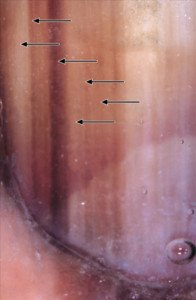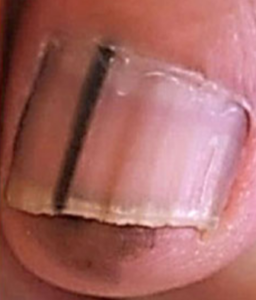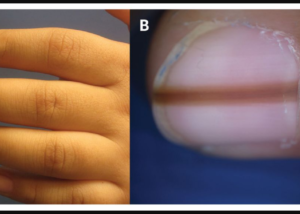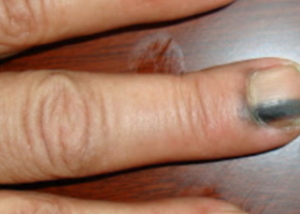How possible is it for a dermatologist to spot nail melanoma by just looking at it?
This begs the question: Can a doctor exclude melanoma by just looking at the nail?
An elongated dark or tan streak, stripe or band in a nail is known as longitudinal melanonychia.
It can have a malignant cause such as melanoma and even squamous cell carcinoma.
But almost always, the condition is benign.
And yes, a harmless longitudinal melanonychia is often diagnosed with just the naked eye.
But what about melanoma?
When the suspicion for melanoma of the nail unit (subungual melanoma) is strong, the patient is urged to undergo a biopsy, which will usually leave the fingertip or toe tip marred.
“The great bulk of longitudinal melanonychia is benign,” says Adarsh Vijay Mudgil, MD, double board certified in dermatology and dermatopathology, and founder of Mudgil Dermatology in NY.
“The key here is examining the cuticle to be certain there isn’t an irregular pigmentation pattern at the most proximal part of the nail.”
Examples of Irregularity
• The individual lines are variegated in color and/or are not parallel to each other.

Archives of Dermatology 2002;138(10)1327-133
• The base of the band (at the cuticle or proximal part of the nail) is wider than the rest, or in more dramatic cases, the band is funnel-shaped – with the broadest part at the cuticle.
If there is irregular pigmentation, “a nail biopsy should be performed,” says Dr. Mudgil.
“If everything appears benign, immediate follow-up with a board certified dermatologist is key if there is any change in nail pigmentation, particularly at the cuticle.”
Changes at the cuticle would include:
• Darkening of pigment
• Widening of pigment
• Spread of the pigment into the skin beyond the cuticle (Hutchinson’s sign)
Melanoma of the nail matrix cannot be officially diagnosed or confirmed with the naked eye.
But…it can be very strongly suspected, and in many of those cases, a biopsy confirms it.
If you’re told that your longitudinal melanonychia is benign, and there was no biopsy, you need to keep surveillance on it for any changes and report those to your dermatologist.
Additional Changes to Watch For
• Overall widening of the pigment
• Hutchinson’s sign of the skin on either side of the nail or above it
• Splitting or destruction of the nail

Hutchinson’s Sign
Any streak or band in a nail should never be inspected with ONLY the doctor’s naked eye. A handheld instrument called a dermatoscope should be used.
Subungual melanoma comprises up to 5% of all melanomas.



 Dr. Mudgil
Dr. Mudgil 







































